Comparative Reliability Assessment of Hybrid Si/SiC and Conventional Si Power Module Based PV Inverter Considering Mission Profile of India and Denmark Locations
Abstract
1. Introduction
2. Reliability Analysis of Hybrid Si/SiC Module Based PV Inverter
3. Results and Discussions
- Reliability-oriented performance evaluation of a PV inverter at the India location;
- Reliability-oriented performance evaluation of a PV inverter at the Denmark location.
3.1. Reliability-Oriented Performance Evaluation of a PV Inverter at the India Location
3.1.1. Calculation of Tj
3.1.2. Rainflow-Counting Algorithm
3.1.3. MCS-Based B10 Lifetime Evaluation
3.2. Reliability-Oriented Performance Evaluation of PV Inverter at the Denmark Location
3.2.1. Calculation of Tj
3.2.2. Rainflow-Counting Algorithm
3.2.3. MCS Based B10 Lifetime Evaluation
3.3. B10 Lifetime Comparison
4. Conclusions
Author Contributions
Funding
Institutional Review Board Statement
Informed Consent Statement
Data Availability Statement
Conflicts of Interest
Abbreviations and Nomenclature
| PV | Photo Voltaic |
| Si | Silicon |
| SiC | Silicon Carbide |
| IGBT | Insulated gate bipolar transistor |
| MP | Mission Profile |
| AT | Ambient Temperature |
| SI | Solar Irradiance |
| Tj | Junction Temperature |
| FETM | Foster Electro-Thermal Model |
| Zth(j−c) | Impedance between junction and case |
| PT | Total losses of power |
| Tc | Temperature of case |
| Ni | No. of Cycles |
| Tjm | Mean Junction Temperature |
| ΔTj | Cycle Amplitude |
| MCS | Monte Carlo Simulation |
| CL | Component Level |
| SL | System Level |
| RF | Rain Flow |
References
- Busca, C.; Teodorescu, R.; Blaabjerg, F.; Munk-Nielsen, S.; Helle, L.; Abeyasekera, T.; Rodríguez, P. An overview of the reliability prediction related aspects of high power IGBTs in wind power applications. Microelectron. Reliab. 2011, 51, 1903–1907. [Google Scholar] [CrossRef]
- Yang, S.; Bryant, A.; Mawby, P.; Xiang, D.; Ran, L.; Tavner, P. An industry-based survey of reliability in power electronic converters. IEEE Trans. Ind. Appl. 2011, 47, 1441–1451. [Google Scholar] [CrossRef]
- Wang, H.; Liserre, M.; Blaabjerg, F.; de Place Rimmen, P.; Jacobsen, J.B.; Kvisgaard, T.; Landkildehus, J. Transitioning to physics-of-failure as a reliability driver in power electronics. IEEE J. Emerg. Sel. Top. Power Electron. 2014, 2, 97–114. [Google Scholar] [CrossRef]
- Amber, L.; Haddad, K. Hybrid Si IGBT-SiC Schottky diode modules for medium to high power applications. In Proceedings of the IEEE Applied Power Electronics Conference and Exposition (APEC), Tampa, FL, USA, 26–30 March 2017; pp. 3027–3032. [Google Scholar] [CrossRef]
- Feng, Z.; Zhang, X.; Wang, J.; Yu, S. A high-efficiency three-level ANPC inverter based on hybrid SiC and Si devices. Energies 2020, 13, 1159. [Google Scholar] [CrossRef]
- Zhang, D.; He, J.; Pan, D. A Megawatt-Scale Medium-Voltage High-Efficiency High Power Density ‘SiC + Si’ Hybrid Three-Level Propulsion Systems. IEEE Trans. Ind. Appl. 2019, 55, 5971–5980. [Google Scholar] [CrossRef]
- Peng, Z.; Wang, J.; Liu, Z.; Li, Z.; Wang, D.; Dai, Y.; Zeng, G.; Shen, Z.J. Adaptive Gate Delay-Time Control of Si/SiC Hybrid Switch for Efficiency Improvement in Inverters. IEEE Trans. Power Electron. 2021, 36, 3437–3449. [Google Scholar] [CrossRef]
- Ning, P.; Li, L.; Wen, X.; Cao, H. A hybrid Si IGBT and SiC MOSFET module development. CES Trans. Electr. Mach. Syst. 2020, 1, 360–366. [Google Scholar] [CrossRef]
- Mishima, T. A Time-Sharing Current-Fed ZCS High-Frequency Inverter-Based Resonant DC-DC Converter with Si-IGBT/SiC-SBD Hybrid Module for Inductive Power Transfer Applications. IEEE J. Emerg. Sel. Top. Power Electron. 2020, 8, 506–516. [Google Scholar] [CrossRef]
- Han, D.; Noppakunkajorn, J.; Sarlioglu, B. Comprehensive efficiency, weight, and volume comparison of SiC- and Si-based bidirectional dc-dc converters for hybrid electric vehicles. IEEE Trans. Veh. Technol. 2014, 63, 3001–3010. [Google Scholar] [CrossRef]
- Saito, K.; Miyoshi, T.; Kawase, D.; Hayakawa, S.; Masuda, T.; Sasajima, Y. Simplified Model Analysis of Self-Excited Oscillation and Its Suppression in a High-Voltage Common Package for Si-IGBT and SiC-MOS. IEEE Trans. Electron Devices 2018, 65, 1063–1071. [Google Scholar] [CrossRef]
- Peng, Z.; Wang, J.; Liu, Z.; Li, Z.; Dai, Y.; Zeng, G.; Shen, Z.J. A Variable-frequency current-dependent switching strategy to improve tradeoff between efficiency and sic mosfet overcurrent stress in si/sic-hybrid-switch-based inverters. IEEE Trans. Power Electron. 2021, 36, 4877–4886. [Google Scholar] [CrossRef]
- Li, Z.; Wang, J.; Deng, L.; He, Z.; Yang, X.; Ji, B.; Shen, Z.J. Active Gate Delay Time Control of Si/SiC Hybrid Switch for Tj Balance over a Wide Power Range. IEEE Trans. Power Electron. 2020, 35, 5354–5365. [Google Scholar] [CrossRef]
- Guan, Q.X.; Li, C.; Zhang, Y.; Wang, S.; Xu, D.D.; Li, W.; Ma, H. An Extremely High Efficient Three-Level Active Neutral-Point-Clamped Converter Comprising SiC and Si Hybrid Power Stages. IEEE Trans. Power Electron. 2018, 33, 8341–8352. [Google Scholar] [CrossRef]
- Li, D.; Li, X.; Chang, G.; Qi, F.; Packwood, M.; Pottage, D.; Wang, Y.; Luo, H.; Dai, X.; Liu, G. Characterization of a 3.3-kV Si-SiC Hybrid Power Module in Half-Bridge Topology for Traction Inverter Application. IEEE Trans. Power Electron. 2020, 35, 13429–13440. [Google Scholar] [CrossRef]
- Feng, Z.; Zhang, X.; Yu, S.; Zhuang, J. Comparative Study of 2Si&C4Si Hybrid Configuration Schemes in ANPC Inverter. IEEE Access 2020, 8, 33934–33943. [Google Scholar] [CrossRef]
- Wang, J.; Li, Z.; Jiang, X.; Zeng, C.; Shen, Z.J. Gate Control Optimization of Si/SiC Hybrid Switch for Tj Balance and Power Loss Reduction. IEEE Trans. Power Electron. 2019, 34, 1744–1754. [Google Scholar] [CrossRef]
- Li, Z.; Wang, J.; He, Z.; Yu, J.; Dai, Y.; Shen, Z.J. Performance Comparison of Two Hybrid Si/SiC Device Concepts. IEEE J. Emerg. Sel. Top. Power Electron. 2020, 8, 42–53. [Google Scholar] [CrossRef]
- Li, Z.; Wang, J.; Ji, B.; Shen, Z.J. Power loss model and device sizing optimization of Si/SiC hybrid switches. IEEE Trans. Power Electron. 2020, 35, 8512–8523. [Google Scholar] [CrossRef]
- Ning, P.; Yuan, T.; Kang, Y.; Han, C.; Li, L. Review of Si IGBT and SiC MOSFET based on hybrid switch. Chin. J. Electr. Eng. 2019, 5, 20–29. [Google Scholar] [CrossRef]
- Song, X.; Zhang, L.; Huang, A.Q. Three-Terminal Si/SiC Hybrid Switch. IEEE Trans. Power Electron. 2020, 35, 8867–8871. [Google Scholar] [CrossRef]
- Noppakunkajorn, J.; Han, D.; Sarlioglu, B. Analysis of High-Speed PCB with SiC Devices by Investigating Turn-Off Overvoltage and Interconnection Inductance Influence. IEEE Trans. Transp. Electrif. 2015, 1, 118–125. [Google Scholar] [CrossRef]
- Naderi, E.; Bibek, K.C.; Ansari, M.; Asrari, A. Experimental Validation of a Hybrid Storage Framework to Cope With Fluctuating Power of Hybrid Renewable Energy-Based Systems. IEEE Trans. Energy Convers. 2021, 36, 1991–2001. [Google Scholar] [CrossRef]
- Naderi, E.; Asrari, A. Experimental Validation of Grid-Tied and Standalone Inverters on a Lab-scale Wind-PV Microgrid. In Proceedings of the 2021 IEEE International Power and Renewable Energy Conference (IPRECON), Kollam, India, 24–26 September 2021; pp. 1–6. [Google Scholar] [CrossRef]
- Kshatri, S.S.; Dhillon, J.; Mishra, S. Reliability evaluation of grid connected pv inverter considering panel degradation rate and oversizing at Indian location. J. Crit. Rev. 2020, 7, 1710–1714. [Google Scholar]
- Global Modeling and Assimilation Office (GMAO). MERRA-2 tavg1_2d_slv_Nx: 2d,1-Hourly,Time-Averaged,Single-Level,Assimilation,Single-Level Diagnostics V5.12.4, Greenbelt, MD, USA, Goddard Earth Sciences Data and Information Services Center (GES DISC). 2015. Available online: https://www.soda-pro.com/web-services/meteo-data/merra (accessed on 1 November 2018).
- Gatla, R.K.; Chen, W.; Zhu, G.; Wang, J.V.; Kshatri, S.S. Lifetime comparison of IGBT modules in Grid-connected Multilevel PV inverters Considering MP. In Proceedings of the 2019 10th International Conference on Power Electronics and ECCE Asia (ICPE 2019—ECCE Asia), Busan, Republic of Korea, 27–30 May 2019. [Google Scholar]
- Bayerer, R.; Herrmann, T.; Licht, T.; Lutz, J.; Feller, M. Model for power cycling lifetime of IGBT Modules? Various factors influencing lifetime. In Proceedings of the 5th International Conference on Integrated Power Electronics Systems, Nuremberg, Germany, 11–13 March 2008. [Google Scholar]

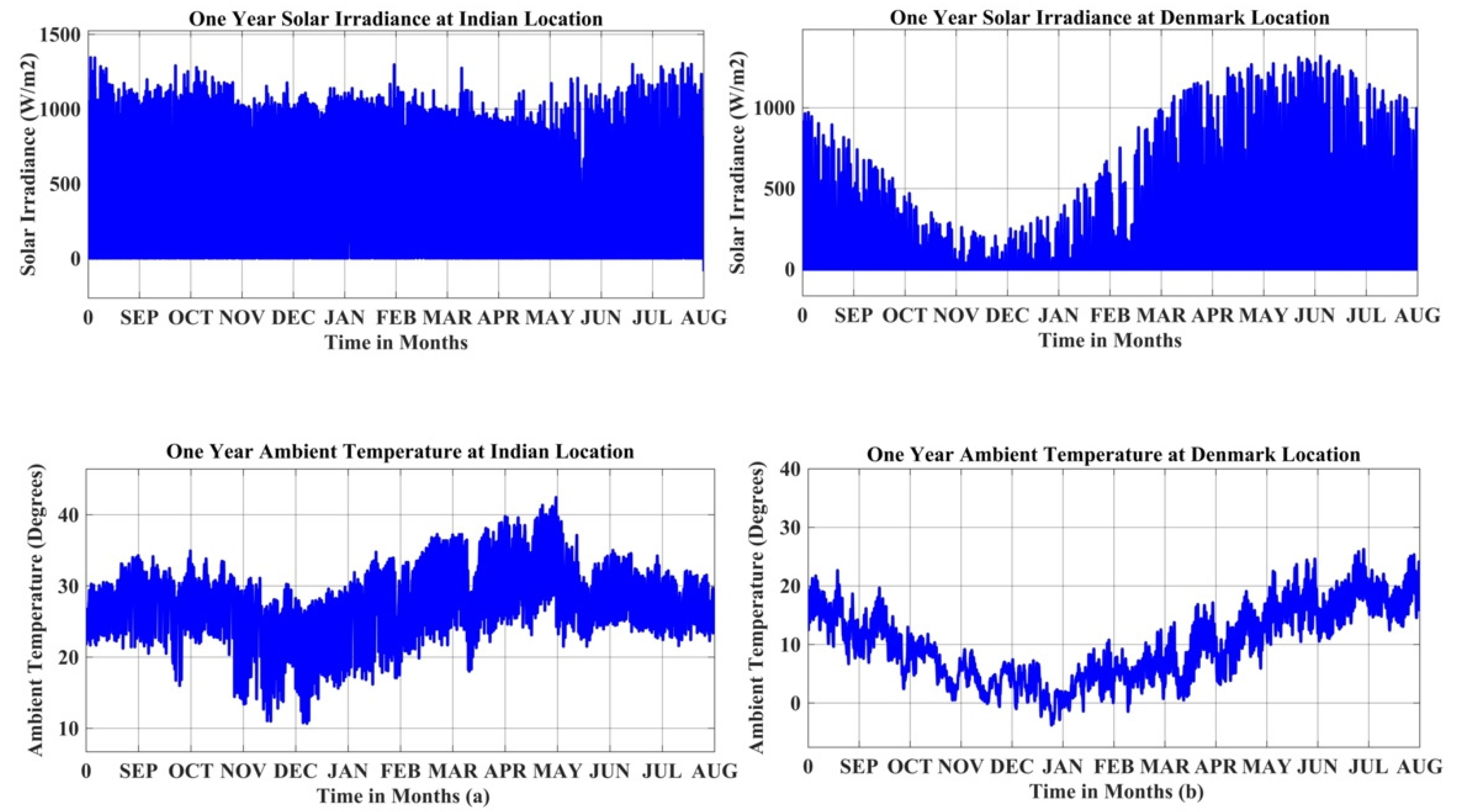
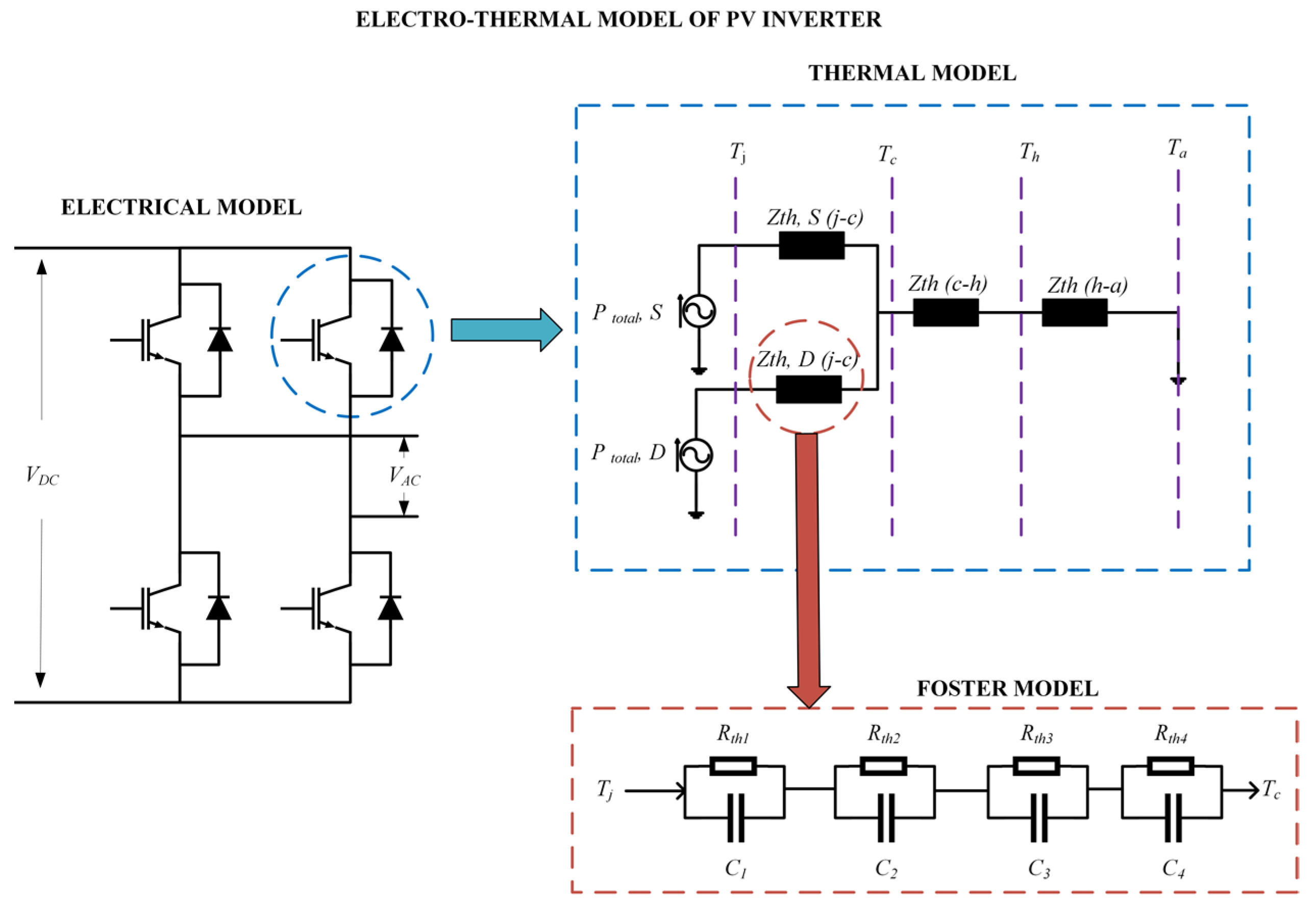

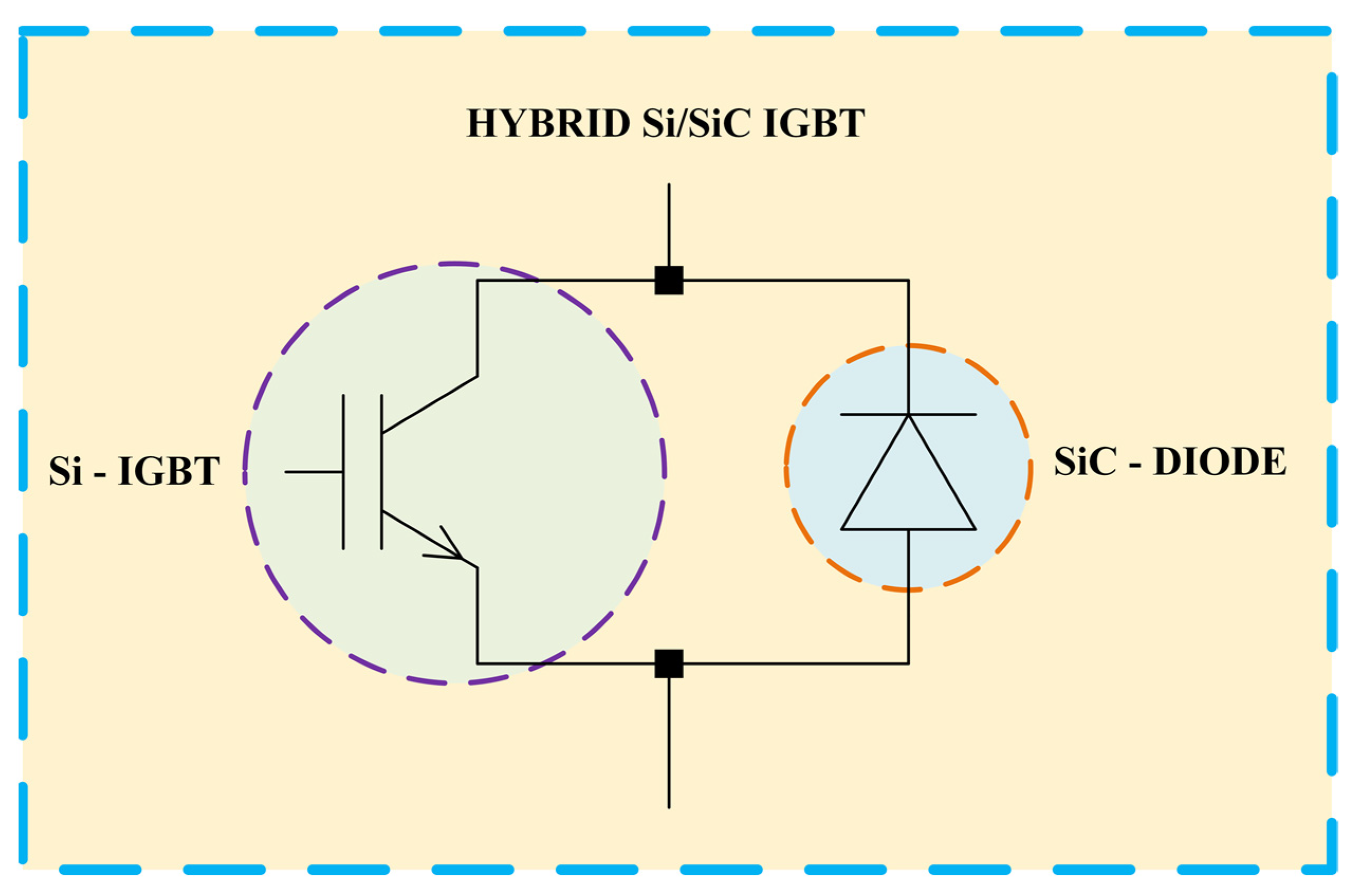
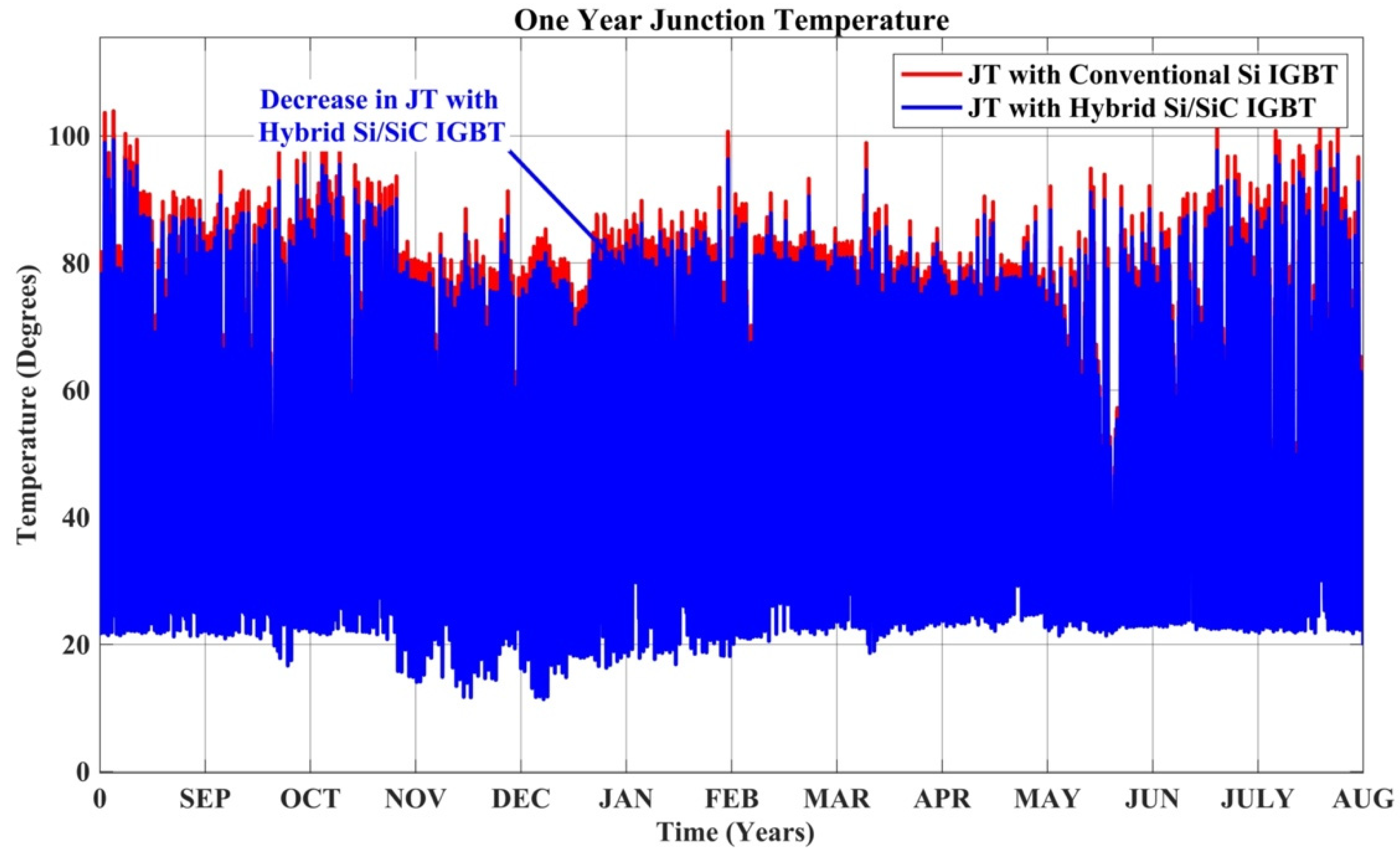


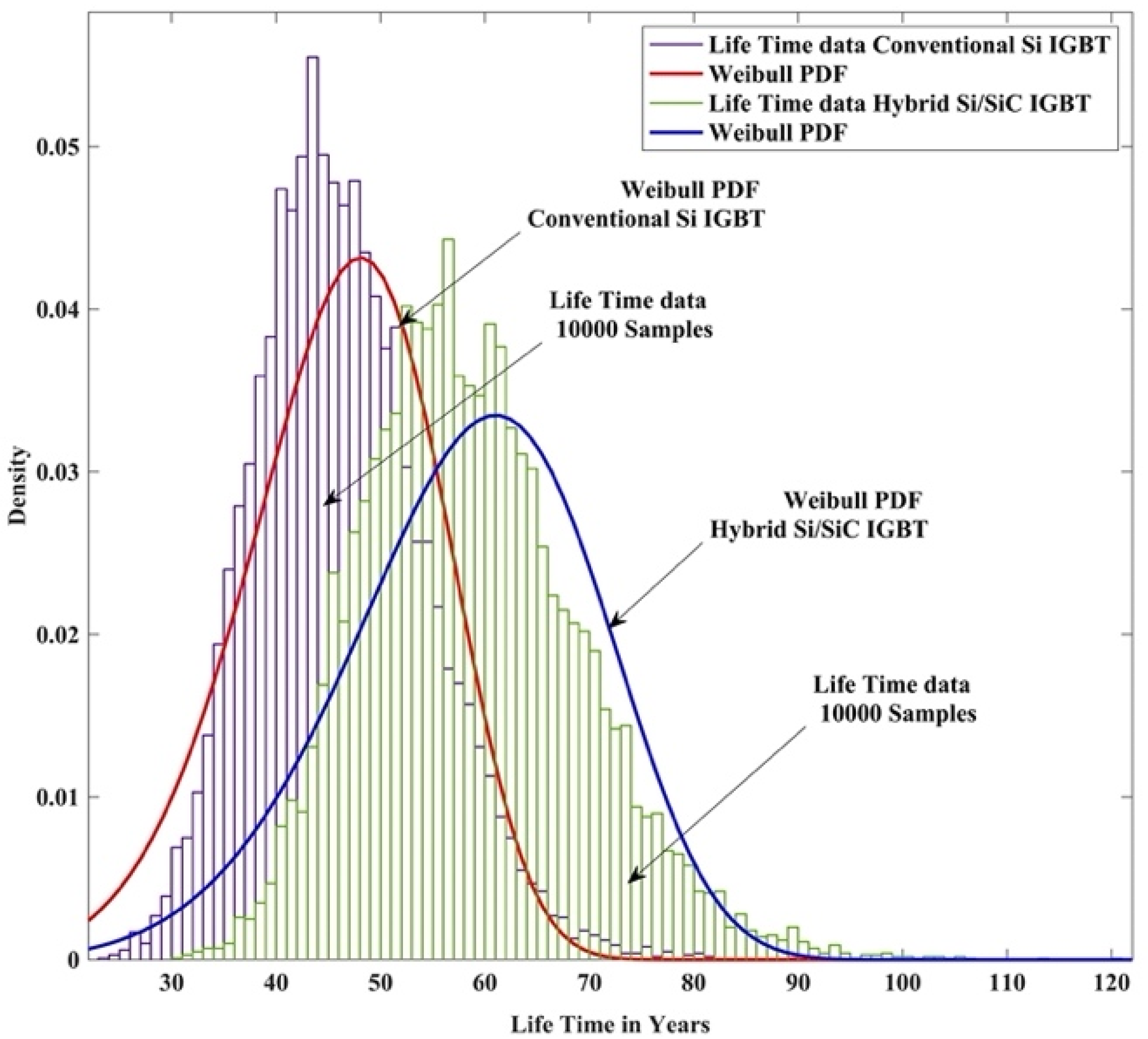
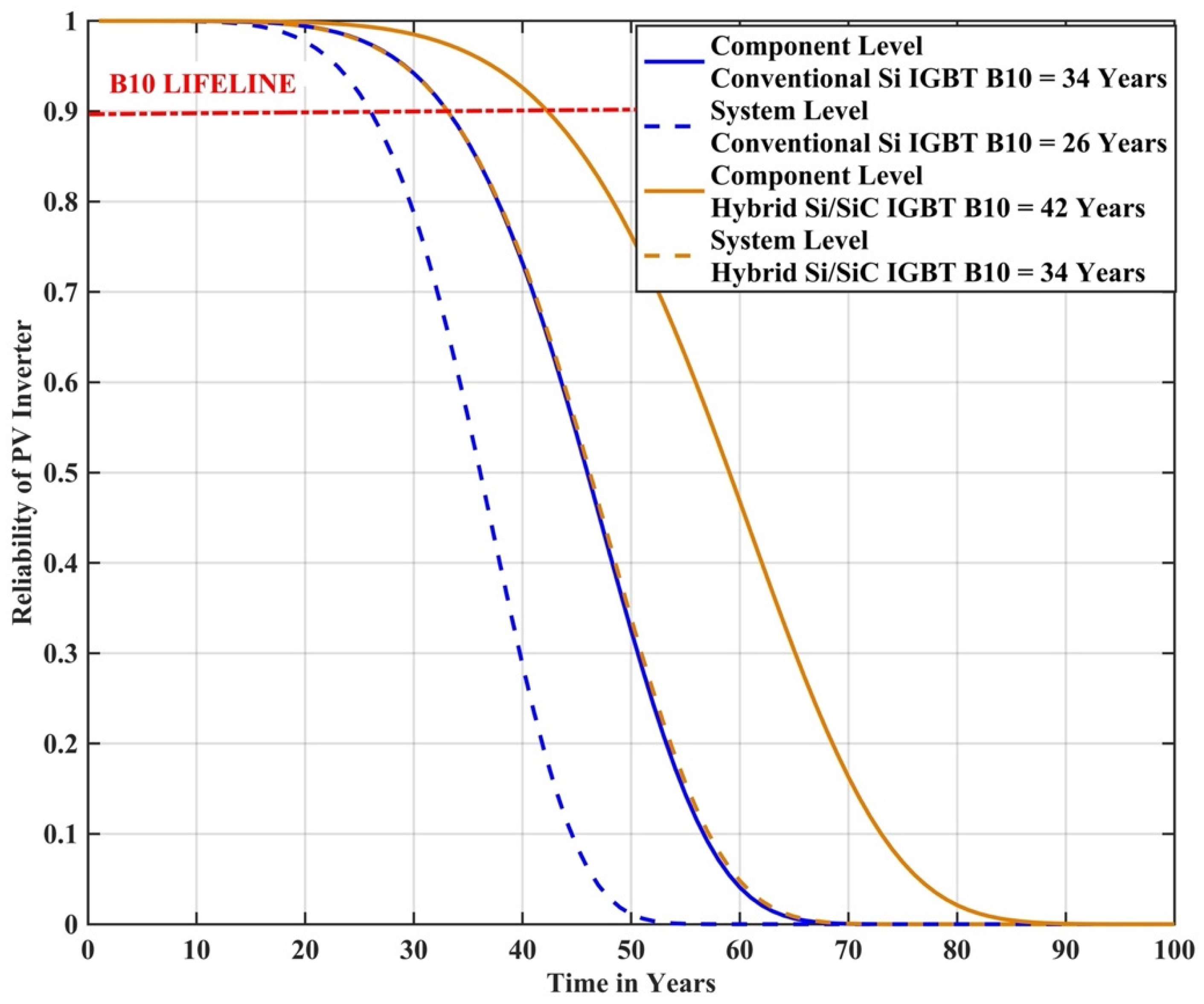

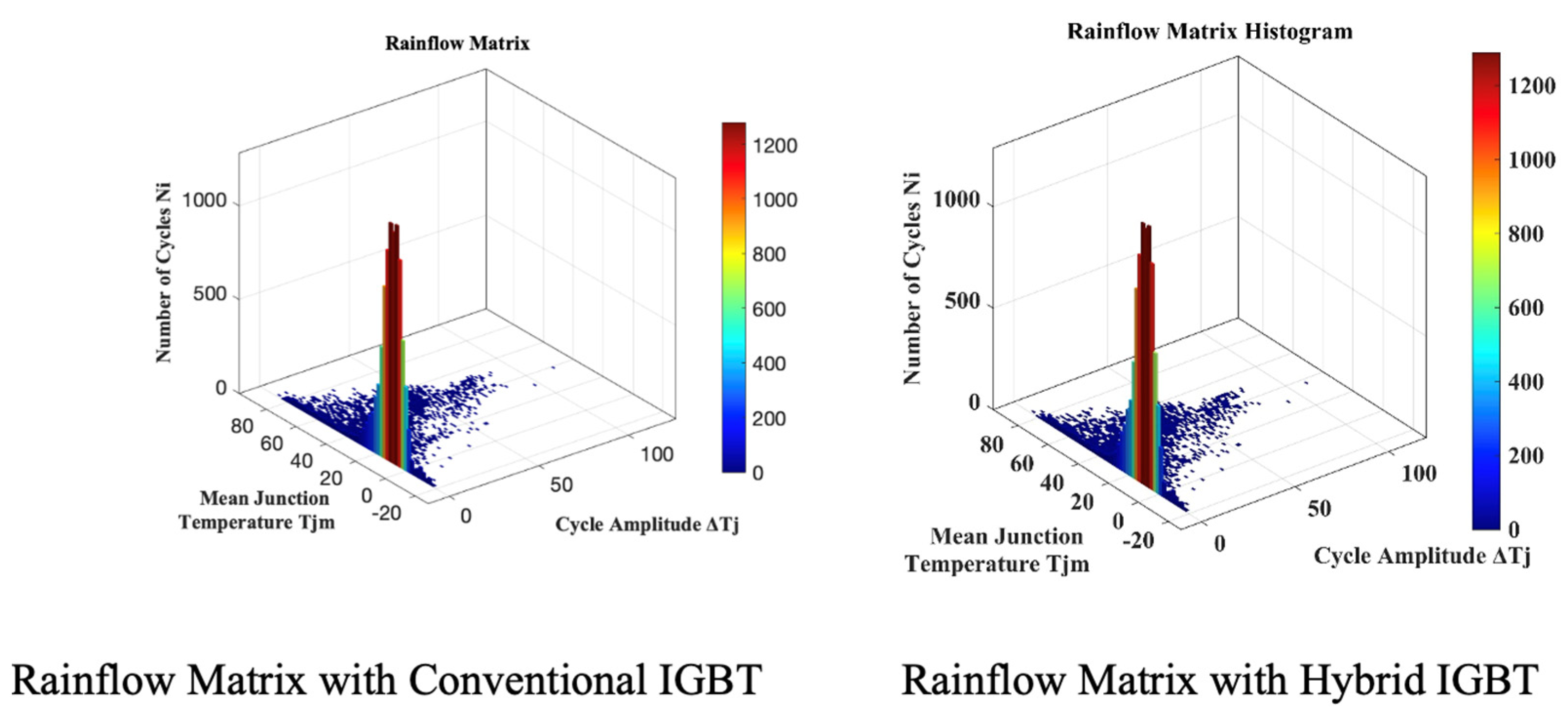
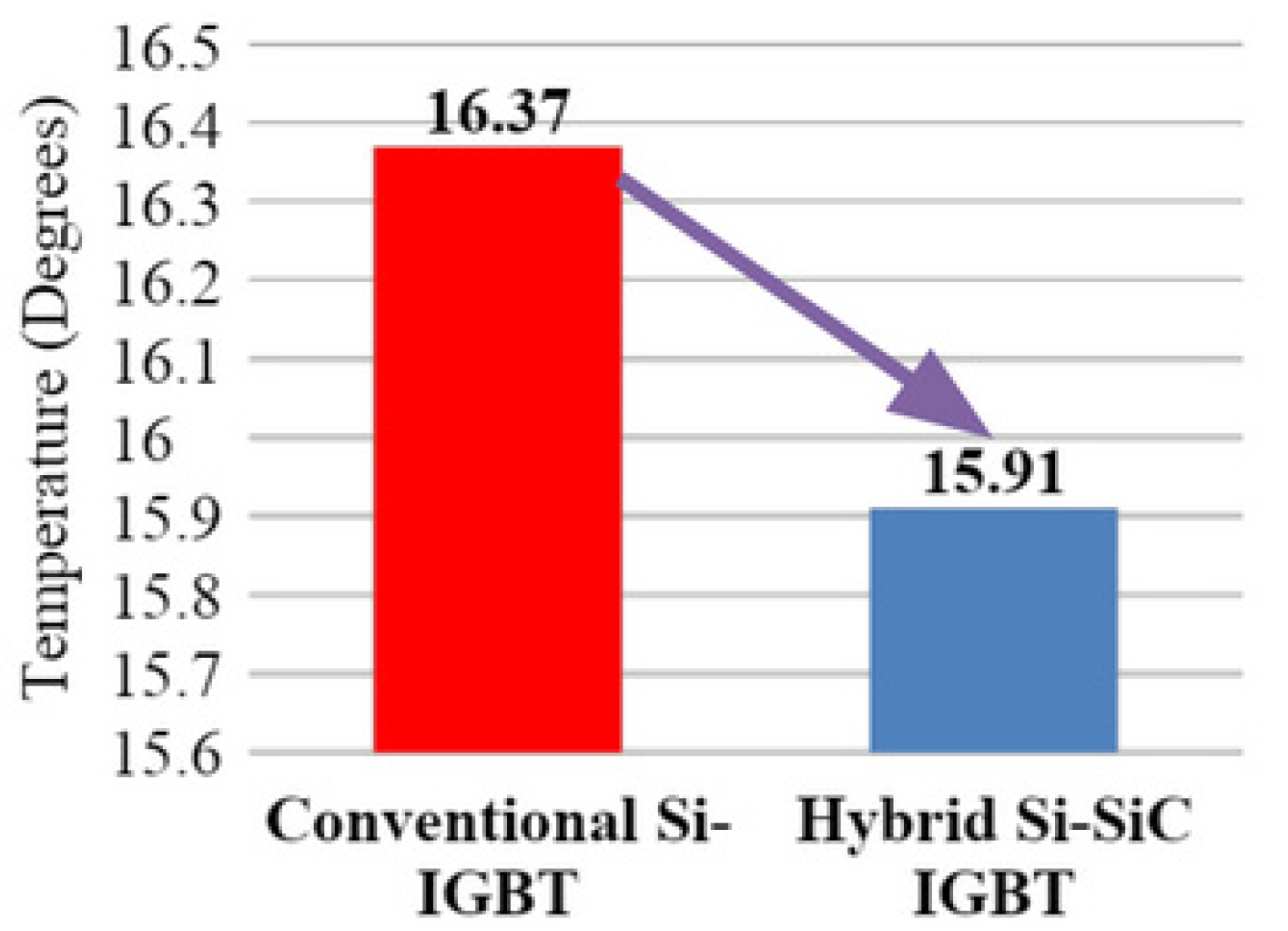


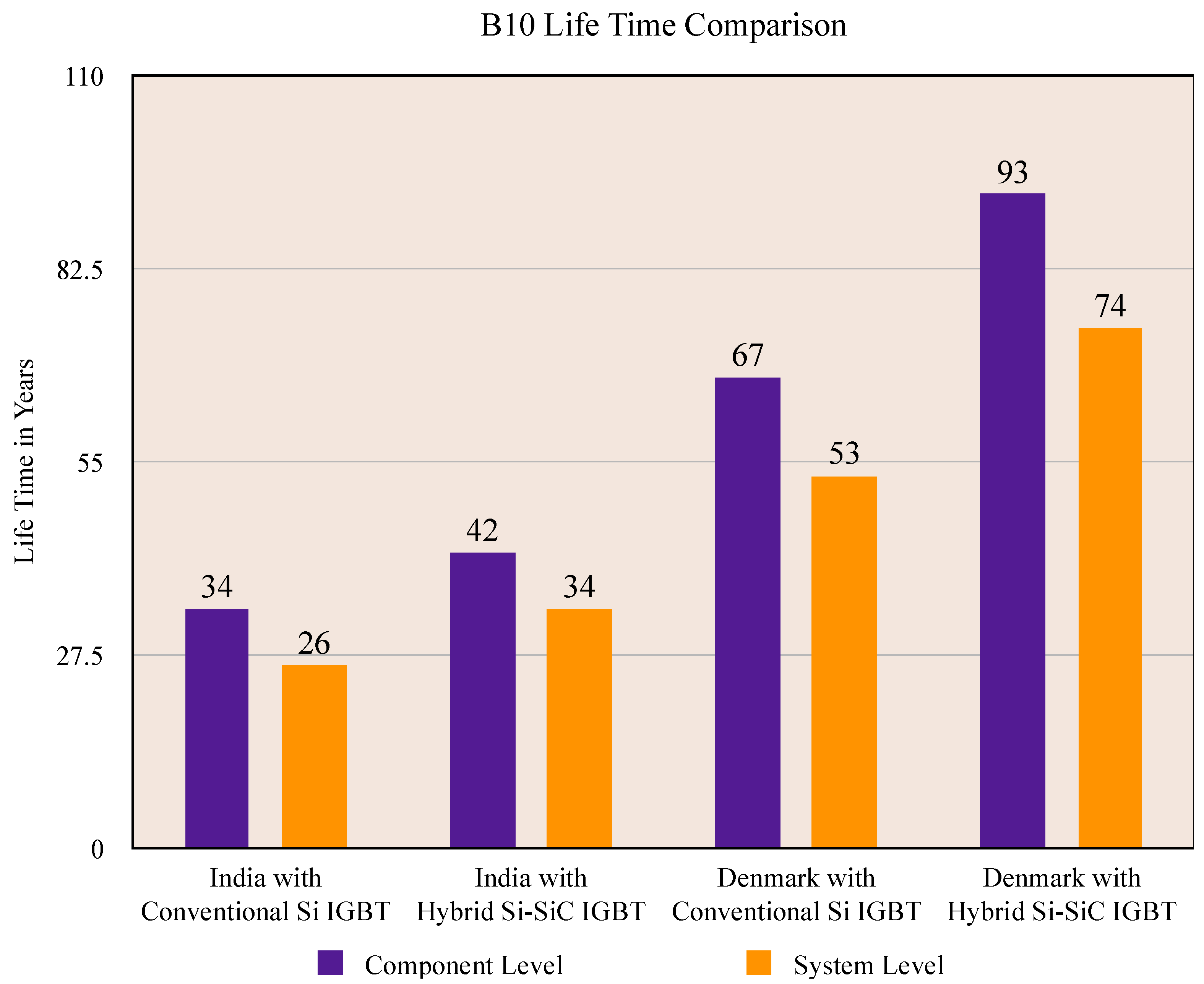
| Name | Number |
|---|---|
| Factor (A) | 9.340 × 1014 |
| β1 | −4.42 |
| β2 | 1285.00 |
| β3 | −0.46 |
| β4 | −0.72 |
| β5 | −0.76 |
| β6 | −0.50 |
| Foot Bond Current (I) | 3–23 A |
| Class of Voltage (V) | 6–33 V |
| Diameter | 75–500 µm |
| Conventional Si-IGBT (In INR) | Hybrid Si/SiC-IGBT (In INR) |
|---|---|
| 237.02 | 1095.28 |
Publisher’s Note: MDPI stays neutral with regard to jurisdictional claims in published maps and institutional affiliations. |
© 2022 by the authors. Licensee MDPI, Basel, Switzerland. This article is an open access article distributed under the terms and conditions of the Creative Commons Attribution (CC BY) license (https://creativecommons.org/licenses/by/4.0/).
Share and Cite
Kshatri, S.S.; Dhillon, J.; Mishra, S.; Haghighi, A.T.; Hunt, J.D.; Patro, E.R. Comparative Reliability Assessment of Hybrid Si/SiC and Conventional Si Power Module Based PV Inverter Considering Mission Profile of India and Denmark Locations. Energies 2022, 15, 8612. https://doi.org/10.3390/en15228612
Kshatri SS, Dhillon J, Mishra S, Haghighi AT, Hunt JD, Patro ER. Comparative Reliability Assessment of Hybrid Si/SiC and Conventional Si Power Module Based PV Inverter Considering Mission Profile of India and Denmark Locations. Energies. 2022; 15(22):8612. https://doi.org/10.3390/en15228612
Chicago/Turabian StyleKshatri, Sainadh Singh, Javed Dhillon, Sachin Mishra, Ali Torabi Haghighi, Julian David Hunt, and Epari Ritesh Patro. 2022. "Comparative Reliability Assessment of Hybrid Si/SiC and Conventional Si Power Module Based PV Inverter Considering Mission Profile of India and Denmark Locations" Energies 15, no. 22: 8612. https://doi.org/10.3390/en15228612
APA StyleKshatri, S. S., Dhillon, J., Mishra, S., Haghighi, A. T., Hunt, J. D., & Patro, E. R. (2022). Comparative Reliability Assessment of Hybrid Si/SiC and Conventional Si Power Module Based PV Inverter Considering Mission Profile of India and Denmark Locations. Energies, 15(22), 8612. https://doi.org/10.3390/en15228612










